
Image: srik.lak
I’m a big critic of Pune as only true lovers of this city can be! Despite its metropolitan ills, the laziness of its shopkeepers, the urban legends about Puneri attitudes, the city grows on you :-). Puneris are very different from the denizens of other cities such as Mumbai. They are quite laid back. But, when you get them going, they can become a powerhouse. This I re-discovered for myself during the recent Tenth Anniversary Celebration of the Wikipedia at Pune.
It all started on 16 December when I realised that unless an appeal was made, no event to commemorate Wikipedia’s Tenth Anniversary on 15 January 2011 in Pune seemed to be materialising . The powerhouse Bangalore was really pushing for a great bash; Mumbai was also jostling around but Pune scene was quiet. Bishakha Datta (Board Member of Wikimedia Foundation, who is located in India) put me in touch with some prominent movers and shakers of Marathi Wikipedia. Unfortunately, some of these guys who had arranged previous meetups, were out of the country while others caught up with events in a busy life. Mahitgar, Abhay Natu and others sent messages of moral support.
The appeal was answered by a few people, notably Sudhanwa Jogalekar, Mandar Kulkarni and Shirish Agarwal and we were off to a start with this motley crue. I had not had the pleasure of attending a meetup in Pune but I wanted that whatever we do should not just be to have a good time but also practically contribute to Wikipedia & Commons.
So the following were proposed in that first email :
- Newbie meet (I volunteer to give an editing tutorial session in English cum Marathi by me but on English Wikipedia. I could be partnered by someone showing the same for Marathi Wikipedia).
- Marathi Wikipedia Meetup.
- Wikimedia loves Pune photothon, where people go and photograph Pune’s landmarks and add them to Commons.
- Outreach activities to schools/colleges?
- Any takers for birdwatching a la Bangalore/Shyamal?”
This was a shot in the dark. We proposed without any idea whether it was achievable and serendipity provided the rest.

The quiet workers - Ashok Bagade, Sudhanwa Jogalekar & Harshad Gune (Image:Prasad Vaidya)
At that point of time, I was attending the 7th Certificate Course in Basic Ornithology run by Ela Foudation and Abasaheb Garware College. Dr Satish Pande and Dr Anand Padhye, the course organisers and mentors, responded very enthusiastically to the idea of contributing to articles on birds seen in Pune. This was to consist of a talk to the course during one of their sessions followed by development of articles. It was planned to bring three articles of bird species to GA quality. This combined two of my wishes – editing of actual articles and also development of the topic ‘birds’.
Mandar Kulkarni, a firebrand editor of Marathi Wikipedia came forth and the Marathi Wikipedia meetup was on. The Pune Photographers group on Flickr responded valiantly to a call for photographers to snap Pune’s heritage. Prasad Vaidya, Anand Patankar and Ashok Bagade responded enthusiastically and I knew that the photothon was on.
The hunt was now on for a hall. Garware College offered to host the meet but their halls had already been booked for the duration. The Symbiosis Institute of Computer Science and Research (SICSR) came to our rescue. SICSR has prominent enthusiasts on “free” issues such as FOSS and Wikipedia – notably Mr Lalit Kathpalia, the Director and Harshad Gune, the Deputy Director. The Director very kindly gave us the facilities gratis and we felt that now our 15 January bash was sure to take place. SICSR hosts Pune Linux Users Group (PLUG) of which Sudhanwa is a driving force. In fact, PLUG and computer science students of SICSR played an important part as volunteers and supporters of our meetup. We sort of stood on their shoulders to arrange the meetups. The computer science students were already innovating extensions for MediaWiki and this too became something for us to highlight.
Moral support

Bishakha Datta (Image:Lane Hartwell)
Bishakha Datta, a board member of the Wikimedia Foundation in India, was our mentor in remote control. She informed us that we could apply for a small grant, which we got, and advised us to form a page on ten.wikipedia.org which we did. Hardly had we made the page when Steven Walling got in touch about promotional swag comprising T-shirts, buttons and stickers being available. Steven sent us the T-shirts well in time but Indian bureaucratese delayed part of the shipment and we had to make do with only half the swag requested. Sadly, it appeared that the Wikimedia Foundation allotted only one VIP per city 😉 (boy, does Bishakha hate it when I use that term for her, he he he, evil me!) Bishakha spent TEN at Kolkata her home city. I’m sure she had a wonderful time but we missed her in Pune.
I had met Sudhanwa Jogalekar for the first time the day after I sent the email along with Dexter, Manjusha Joshi and Alolita Sharma in the famous restaurant Hotel Rupali on Ferguson College Road. A very auspicious start to a new friendship with this quiet, white-haired, FOSS evangelist who was to prove the bedrock of our organising the meetup.
Serendipity & all that
We had our first meetup at SICSR canteen around the 20th or so of December. That day, I met Mandar and Shirish for the first time – new friends. 🙂
I had mentioned “serendipity” before. The day of our first co-ordination meeting in SCISR canteen, we found a group of young college students excitedly and noisily discussing on the next table. We began discussing and during one of our pauses we heard the magic W word! Immediately we called them over and we found that this was a volunteer group of TEDxPUNE headed by the Curator in Pune, 19 year old Abhishek Suryavanshi who were organising a day-long evangelisation meetup for school children on 15 Jan in SCISR itself! Wham, the synergies hit us. The TEDxPUNE meetup became another of the activities Pune could boast about and present in the meetup. In return, we would provide an editing session by volunteers (yours truly) and share some of the promotional swag. So our evangelism wish also came true.

Dr Anupam Saraph - CIO Pune & Mentor TEDxPUNE (Image:Prasad Vaidya)
TEDxPUNE is mentored by Dr Anupam Saraph. Anupam is a polymath, an evangelist of infomatics and a great supporter of the Wiki concept and in his capacity as Chief Information Officer of Pune, had implemented a governance wiki for Pune. Anupam was in touch with Wikimedia Foundation on a number of issues. Unknown to us he was convincing Barry Newstead, Wikimedia’s Chief Global Development Officer (CGDO) to visit us in Pune. Barry was coming to Mumbai, ostensibly on work and would attend the Mumbai meetup that morning. At that point of time, exciting things were being planned in Pune. Barry wrote mentioning that he would be in Pune for our function. We were really excited.
A Note about Barry Newstead

Barry Newstead, Chief Global Development Officer, Wikimedia Foundation (Image:Lane Hartwell)
(blurb begins) – he became CGDO in Jun 2010 and was responsible for increasing readership and supporting editor self-organization in the Global South, for overseeing communications with the general public and the media, and activities aimed at supporting and developing chapters. Newstead joined Wikimedia Foundation from The Bridgespan Group, where he spent the previous year helping the Wikimedia Foundation develop its five-year strategic plan. Previously, he worked with The Boston Consulting Group (BCG) for eight years where he worked extensively in southeast Asia, greater China, South Korea and western Europe. Barry was born in Cape Town, South Africa, and raised in Toronto, Canada. He has an undergraduate degree from the University of Western Ontario, and a master’s degree in public policy from the John F. Kennedy School of Government at Harvard University. Barry has been married to P. K. Lee for 12 years. (blurb ends) Barry is a very nice guy, intelligent and well-informed and it was a real treat for us to interact with him.
Schedule
So now our activities were planned as follows:
- WIKIPEDIA INTRODUCTION & EDITING SESSION to Basic Ornithology Course at 1930 hrs on 06 Jan 2011 in Abasaheb Garware College.
- WIKIPEDIA MARATHI MEETUP at 1830 hrs on 08 Jan 2011 at SICSR.
- PUNE PHOTOTHON FOR WIKIMEDIA COMMONS at Shaniwarwada at 0930 hrs on 09 Jan 2011.
- BIRD ARTICLE IMPROVEMENT SESSIONS.
- TEDxPUNE EVANGELISM at SICSR on 15 Jan 2011 from 1000 hrs to 1600 hrs.
- ‘Introduction to Wikipedia & editing session’ by yours truly from 1200hrs to 1400 hrs. Barry Newstead to attend on arrival from Mumbai.
- TENTH ANNIVERSARY CELEBRATION at SICSR from 1830 hrs onwards.
- Dinner for Barry Newstead and few volunteers. After the function.
For the function itself, we had planned :
- Presentation on Wikipedia (ten minutes).(Ashwin Baindur)
- Short talks on:
- Marathi Wikipedia (ten minutes) (Mandar Kulkarni).
- 7th [[Ornithology]] Course’s contribution to Wikipedia with Uploading of the three improved articles on Indian Birds (ten minutes). (Dr Satish Pande)
- Talk on contribution to Wikimedia Commons with symbolic upload of a photograph, from Wikimedia Commons loves Pune (ten minutes). (Ashok Bagade)
- Talk on contribution made by TEDxPUNE’s event for college students on 15 Jan 2011 (ten minutes). (Abhishek Suryawanshi)
- Talk on Software extensions developed by SICSR – (ten minutes) (Harshad Gune).
- ””’Hallmark address by Mr Barry Newstead from Wikimedia Foundation.””’
- Concluding remarks by Lalit Kathpalia.
- Cake cutting.
- Vote of thanks (Mandar Kulkarni).
- Refreshments.
Ornithology Course Wiki Meetup

Dr Suruchi Pande, noted ethno-ornithologist, Ela Foundation
The Introduction to Wikipedia meetup to the 7th Certificate Course in Basic Ornithology at 1930 hrs on 06 Jan 2011 in Abasaheb Garware College. It was a thirty minute slot given to us. Sudhanwa and Shirish, the mainstays were present and Ashwin (yours truly) took the lecture. The lecture introduced the need for Wikipedia and Commons, the philosophy and showed how simple it was to edit. Thanks to Swapnil for helping with internet when our internet dongle and backup dongle both failed. After the function Tshirts were presented to Doctors Satish and Surchi Pande, Anant Padhye and Anil Mahabal and those who were actively involved in editing in the project. The course was enthusiastic in the reception of Wikipedia editing as an idea but it will need more follow ups to convert some of these interested people into Wikipedia editors.
Marathi Wikipedia Meetup
The Marathi Wikipedia meetup took place at SICSR at 1900 hrs on 08 Jan 2011. The following attended – Ashwin Baindur, Shirish Agarwal, Sudhanwa Jogalekar, Anupam Saraph, Mandar Kulkarni, Karunakar, Harshad Gune and couple of newbies to the concept of wiki editing. Discussion reigned on three topics – the forthcoming anniversary activities (by self), efforts to introduce wikis in the commercial, educational and government communities and the desirability of making Pune a contender for the location of Wikimedia’s India Office (by Anupam Saraph), and the road ahead for Marathi Wikipedia (by Mandar Kulkarni). Mandar gave a number of ideas. See Mandar’s presentation loaded /*here*/.
Shirish Agarwal has given a detailed writeup on that event /*here*/:
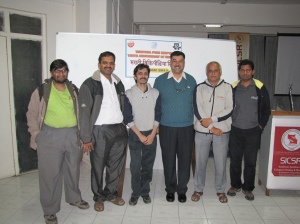
Marathi Wikipedia Meetup at Pune on 08 Jan 2011. L to R - Shrish, Mandar, Harshad, Ashwin, Sudhanwa, Karunakar. Anupam left early.
Wikimedia Commons Meetup
The Wikimedia Commons meetup took place on 09 January 2011. A bunch of (camera) trigger-happy people metup on Sunday morning at the front gate of Shaniwar wada. Those present included Ashwin Baindur, Anand Patankar, Ashok Bagade, Shirish Agarwal, Sudhanwa Joglekar, Prasad Vaidya, Chandan Sharma and Prasad Rasal. Since everyone was meeting afresh, the first act of the day was explaining our purpose – the idea behind Wikipedia and Wikimedia Commons, the need for free images on Pune and our plan for the group which we christened as WikiPuneri. The need to do this today, namely, the forthcoming 10th Anniversary of Wikipediawas mentioned along with a special invite for the 15th event. WikiPuneri members played a major role on the 15th.

WikiPuneris all - Shirish, Chandan, Anand, Prasad, Ashwin (Image:Anand Patankar)
The photographers soon sorted out into two groups – some to whom photography is serious business and others who consider it a great social activity. I shuttled between both as they pored over the grounds of the old fort and photographed it comprehensively. After that we went to Kasba Ganpati mandir, Lal Mahal (closed due to the relocation of Dadoji Kondadev’s statue) and had Misal-Pav at the close. Prasad Vaidya, the most energetic of photgraphers promptly created a WikiPuneri group on Flickr and Facebook. It is early to say but we hope that WikiPuneri will grow into something good which contributes usefully to Pune’s heritage. The photographers took awesome images some of which were showcased during the 15th function.
Shirish Agarwal gives an interesting writeup /*here*/ .
Bird Article Improvement
The Bird article improvement took place at Dr Satish Pande’s residence since he had both a laptop with internet connection and the references. The contributors comprised of Dr Satish Pande, Dr Suruchi Pande, Dr Anil Mahabal, Rajgopal Patil and Devashish Pandya. Yours truly was the editor as there was no time to teach wiki editing to the particpants. A number of edits were made with references. The article on Common Myna (Acridotheres tristis) was developed with a great number of details ranging from distribution to culture. Earlier the crux of the article was by myna-haters from countries where it is an invasive pest. It has been successfully converted into an article with NPOV – containing material both by myna-lovers from India & myna-haters ;-). Besides this information on Indian populations of Shaheen Falcon (Falco peregrinus peregrinator), White Stork (Ciconia ciconia) and others. A unique first was when the Painted Francolin (Francolinus pictus) article was provided not just its call by yours truly but also its sonogram by Rajgopal Patil, we hope it is a sign of good things to come.

The improved article on Common Myna on Wikipedia
The Big Day dawns
Last minute changes and emergencies come up. Ashok Bagade had a severe attack of pharyngitis and Chandan Sharma stepped in at the last minute to speak instead of him. The program changed. Anupam had asked Barry to come relatively early to Pune, be in Pune by 1500 hours and attend firstly – an open session of the kids who had attended the evangelism get-together and later a meeting with movers and shakers of Government and Industry in YASHADA. After that Barry would attend our meetup. So now a new serial was added into our program:
- Meeting of Barry Newstead with bureacrats and captains of industry from 1700 hrs to 1800 hrs on 15 Jan 2011 at YASHADA.
The cake guys refused to accept our cake design because it had a nation’s map on it – something they had not sensitised us to earlier. Worse, they refused to explain why they were rejecting our design till finally their chief creator of cakes at Copperchocks, Sharon explained the situation to us – that people object to the cutting of the national flag or map on a cake. On our pleading, Sharon, much to her surprise, found herself agreeing to do the cake at short notice. We chose one of Srikanth Lakshmanan’s designs from /*here*/.
Thanks to Tony Thomas and Swapnil Narendra, creators of the design we chose. You guys are entitled to cake, when you visit us in Pune.

Our awesome cake - based on a "free design"!
Next, the printers/publishers acted up and last minute running around was required by to be done by Sudhanwa. As a result all of us got involved and could not partiipate much on the 15th in anything but our function. I had an editing session to do which I did but that’s it. Fortunately, we had kept our blogger free to absorb all impressions and Shirish was deputed to attend and report – a task which he has done admirably. Or will have done admirably, once all his posts are up!
TEDxPUNE Wikipedia Event
The 15th morning saw us all phoning each other to coordinate eveything. I landed up at TEDxPUNE bang on the clock at 12 noon for my session. The children were all busy, innovating a parachute from various items of garbage given to them. After about half an hour, my time came. As luck would have it, the internet on the LAN misbehaved and I had to speak cold turkey to the kids till internet was restored 45 mins later by Saharsh Parekh of SICSR – great job, Saharsh, way to go. That gave me an opportunity to tell the children the philosophy about Wikipedias and Commons. Also that it was one of the very few places where they can make a difference and change the world. Our editing session that followed was exciting but necessarily brief – we added some information on Ganeshotsav and deleted some unreferenced information from the wikipedia article on Culture of Pune. Then I had to leave.

With the kids at TEDxPUNE Wikipedia event. (Image:Abhishek Suryawanshi)
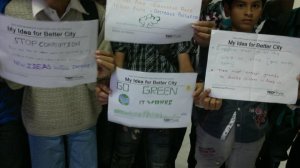
Children display their posters (Image:Abhishek Suryavanshi)
The children had a poster competition and I was really gratified to hear that they had got the message clearly – they churned out some fabulous posters which Barry Newstead was shown at his arrival at 1630 hrs. (You actually believed the Mumbai guys would let him go so easily? Hah!). He had a great time interacting with the kids and departed for YASHADA. We shall be uploading the kids posters to Commons soon.
YASHADA Meetup
The YASHADA meet was NOT about Wikipedia but about the understanding/using the concept of wikis in government, business and acdemicia – though to be fair, Anupam lobbied hard for scholarships to school teachers & students who would contribute to Wikipedia/Wikiversity. Let’s hope he succeeds. Shirish has a detailed writeup on his blog for those interested in this field.

Shirish makes a point at Yashada meetup. (Image:Yashada)
The last minute hitches
The final meetup began slowly. Our time-plan had gone for a six. We hoped that Barry would revert very soon from YASHADA but that was pointless optimism. People turned up slowly but steadily and we were relieved to find our hall fill up by 1900 hrs (we had catered for 150). The TEDxPUNE volunteers led by Abhishek Suryavanshi and SICSR volunteers led by Saharsh Parekh were a boon to us and quickly helped us set up our show. Anand Patankar and Ashok Bagade landed up gingerly but triumphantly holding our cake. It was a real beauty – easily the prettiest cake in all the WP celebrations in India.
Ashok, though speechless, landed up with a sizzling presentation on Shaniwar wada for Chandan to showcase. Chandan Sharma and her sister Poornima landed up, both looking gorgeous and adding some much needed colour to our meetup. Immediately, they got together with Amita, my better 99% and Aditi my daughter (who came along to participate and also give me moral support) and took administrative charge of cakes, T-shirts, people etc. They organised our reception, etc so that I could quit flapping. Sudhanwa landed up at last minute with the beautifully printed handouts/booklets that we dished out. (Sorry, folks, we are all out! Don’t worry, you can download it from /*here*/.)
Tenth Anniversary Function
Since the program could not effectively began without Barry, yours truly got a chance to put his gift of the gab to work. The audience was fantastic. They neither booed me or chased me with paintbrush and tar-bucket but listened spell-bound for an hour as I put forth the whole philosophy thing and very, very slowly went over my presentation on WP. In short, they were good as gold.
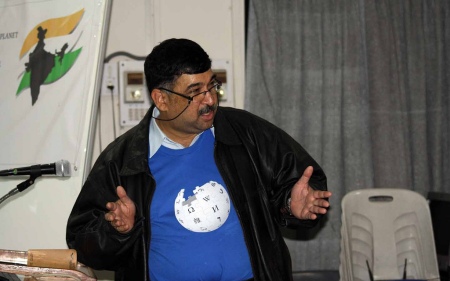
Yours truly - pontificating at large! (Image:Prasad Vaidya)
I was also able to inform the public about our activities in general and introduce the wikipedians to them. The editors of Wikipedia were then asked to stand up and introduce themselves. The youngest editor was 15 year old Rishabh Tatiraju or User:Tatiraju.rishabh who has a thousand edits and mostly edits on tropical cyclones. He and my daughter, Aditi, formed the reception committee.
Special Note to Editors from Pune on Wikipedia especially those who attended : Extra T-shrits have come. Leave message on User Talk:AshLin if you are a genuine editor. Minimum 50 edits are a must to collect your Tshirt. First come, first served but do not forget to post me on English Wikipedia on my talk page in any case.

Rishabh Tatiraju - the youngest editor present (Image:Prasad Vaidya)
At around 7.45 Barry, Lalit, Anupam & Shirish arrived, to my relief. I wound up my spiel and launched the people reporting on the multifarious activities one by one.

Dr Satish Pande entertains us all. (Image:Prasad Vaidya)
The first was Dr Satish Pande. Without any presentation of any kind, in simple language he mentioned why the Ela Foundation decided to take up this project and how they went about it. He mentioned the unique contributions such as the addition of very interesting ornithological facts, especially the bird call sonograms which had never been added to Wikipedia before. He regaled the audience with some very interesting names for the Common Myna in Sanskrit literature. The information on Sanskrit names was provided by Dr Suruchi Pande who has doctorates in Sanskrit and History and is working on Ethno-ornithology of Indian culture while the information on so many other aspects of Myna biology were provided by Dr Anil Mahabal who has made his life’s study on this bird. The short talk was very well recieved by the audience. At the end of it, the expanded and revised article on Common Myna was uploaded in front them.

Mandar Kulkarni (Image : Prasad Vaidya)
After this, Mandar Kulkarni gave a presentation on Marathi Wikipedia, a revised version of what he presented in the Marathi Wikipedia meetup. Dressed impeccably in formals, Mandar made a striking figure. His strong beliefs and enthusiasm shone through as he mentioned the different ways we can help to develop this indic language wikipedia of our home state. Mandar mentioned a number of ways we could contribute from creating new articles, translating en:WP (English Wikipedia) articles, adding information, images, references, inter-wiki linking (linking different language versions of an article), marketing WP through social networking such as FB & twitter, etc, etc. My only regret was that for want of time and opportunity we had only paid lip service to mr:WP (Marathi Wikipedia) and could not have made a real contrubution as had been done for en:WP and Commons.
Mandar was followed by Chandan Sharma who spoke of how it was an intriguing to be invited to Shaniwar wada for photography and how the whole idea of photographers contributing to Pune, Wikipedia and Wikimedia Commons was an awesome way to contribute to society. For those who don’t know. Commons is the image and media repository providing free images to all the 278 language Wikipedias, other projects and to the general public. Chandan explained how a large collection of images on Pune’s monuments was a surefire way to promote the city and empower its people. The photographers group, spearheaded boldly by Prasad Vaidya had formed Facebook and Flickr groups called WikiPuneri. She then wowed the audience with Ashok B’s (he with the speechless voice) presentation.
Then in front of every one the first image – of Shaniwar wada’s front gate – was uploaded into Wikimedia Commons. Here it is :

"Dilli darwaja" at Shaniwarwada - our first image to be loaded into Commons
Due to time constraints, we had to cancel the talks by the next two speakers, Harshad Gune on PHP extensions created by the students of SICSR and Abhishek Suryawanshi reporting on the TEDxPUNE. They took this very sportingly without a single word of complaint. Though I had mentioned their contribution to the audience, we were all a bit disappointed at that. We are looking forward to Harshad Gune’s boys demonstrating their coding skills on MediaWiki next month at GNUNIFY in their College. But it was late, a few people had begun leaving without hearing Barry speak or even partaking cake and refreshments, so we had to cut short the programme.
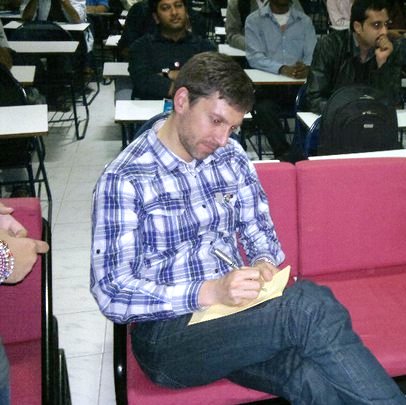
Barry Newstead at the Meetup
Barry’s Talk
Barry Newstead stood up and in a frank, soft-spoken tone told us all about Wikimedia’s worldview.
Amit Karpe’s blog post gives the points succintly which I am paraphrasing below :
* Wikimedia Foundation’s plans for next 10 years.
1) Secured Infrastructure
2) Increasing Participation of all stakeholders
3) Quality ( Rating Tool ) under test
4) Increasing reach of Wikipedia to offline audiences ( Books, CD, Pendrive )
5) Innovations
* India is on priority. Notably, Barry had travelled 3 times in last 5 months to India. India has a large reader community with more than 30 Million monthly visitors on the total projects of wikimedia.org. Though we now have significant Indic language communities, there is tremendous scope for growing and improving India is important for Wikimedia Foundation because:
1) Opportunities
2) Free Knowledge
3) Hub for Innovation
4) Office in India ( Only Office outside US )
* Barry explained the significance of the logo:
1) More I learn, less I know.
2) Knowledge puzzle yet to complete represents the work yet to be done and knowledge yet to be added.
3) Knowledge 1% uploaded in Wikipedia and 99% yet to come not vice versa.

Barry Newstead points at the logo explaining it stands for the work yet to be done.
Barry then cut the delicious cake and while the cake was being apportioned, Mr Lalit Kathpalia, the jovial Director of SICSR gave a short and sweet summing up. He reiterated the support of SICSR in development of technical projects for Wikipedia and invited Barry to visit SICSR in Feb 2011 for the college techfest GNUNIFY. Lalit has generously offered to help implement whatever changes ordinary Wikipedians would like to see in MediaWiki. More power to him and his coders!

Mr Lalit Kathpalia, Director SICSR, concludes the session. (Image: Prasad Vaidya)
Mandar Kulkarni gave the vote of thanks and the proceedings came to an end. Everybody was ravenous and the excellent snacks provided by SICSR canteen contractor vanished as fast as they appeared but since there were only 63 guests at the end, there was enough tuck left over for the hostelites among SICSR volunteers to take with them.

Chandan and Aditi clap as Barry cuts the cake. (Image:Abhishek Suryawanshi)
Epilogue
The dinner at Raviraj for Barry to interact with a few of the volunteers was a pleasant, quiet affair with interesting conversations and ideas being thrown around. Everyone unanimously heckled Barry (in a pleasant way of course) to locate Wikimedia’s office in India in Pune. A large variety of reasons were given and Barry smilingly kept nodding without committing – a very diplomatic effort on his part. A great time was had by all and we broke off at 12.30 pm. Thanks to Prasad Vaidya for his flawless organisation of the dinner party single-handedly.
Special Thanks to : Wikimedia Foundation, Bishakha Datta, Barry Newstead, Steven Walling, Winifred Olliff.
We also thank Sakaal Times, Times of India, Indian Express, DNA, Maharahstra Times for their press coverage of the event.
18.584495
73.837312







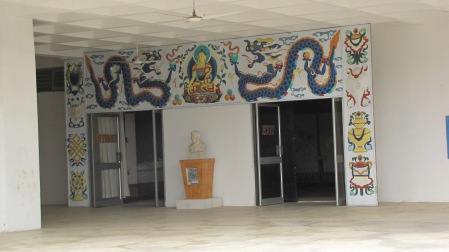



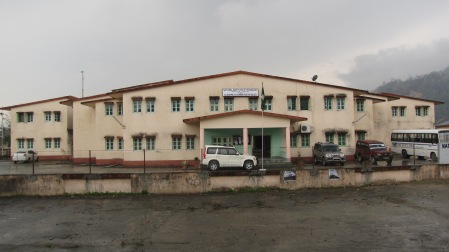
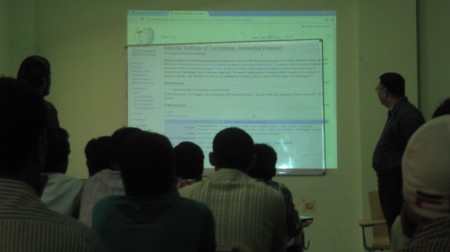


























Recent Comments